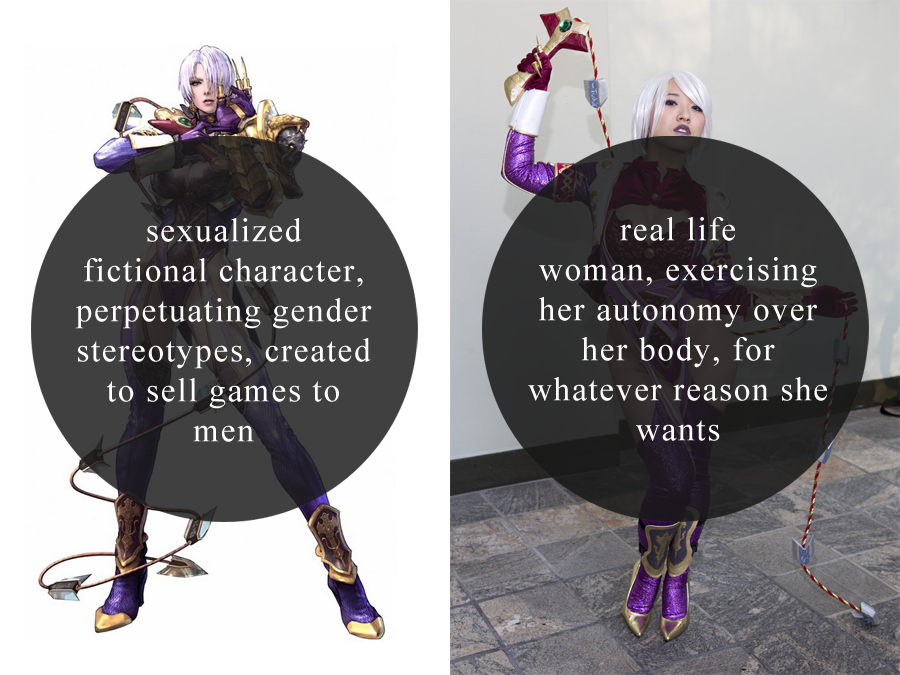
cosplay by Stella Chuu / cosplay photographed by madcatdrannon.deviantart.com / illustration © Namco
When it comes to criticism on matters of representation – gender representation or race representation or any other group – It’s important and kinda tricky to make sure, we do not debate the real life people and their choices, but keep the focus on the representations of them in media.
It’s more complicated, than one might think. Here is why and how.
Representation
Criticism towards representation can easily slip into criticism of the people who are represented. The criticism is about design decisions and goals. It’s about how creators chose to conjure up fictional characters in order to serve a specific communicative goal. It’s about how fictional characters are made to look, made to behave, and are framed by creators, not criticism about how real life people look, behave or the situations they find themselves in. While this sounds rather obvious, in practice this distinction gets easily overlooked.
For example criticism about sexualization in media – pointing to heavily sexualized female characters – can easily be read as condemnation of real women who choose to present themselves sexually. Rejecting pinkification in media and merchandise can easily be understood as an attack on women and girls who choose to have pink as a favorite color.
Criticism about media representation challenges systems and memes which perpetuate oppressive paradigms and confine people into boxes. This is the exact opposite of criticizing individuals and how they decide to present themselves. Feminist criticism aims to enhance the ability of women to exercise autonomy over their own body and life, not scold them for it.
Real women?
An clear example where critics often fall into that trap is debate around skinny fashion models. The beauty ideal created by the extreme skinniness in media – often preferred by fashion magazines, fashion companies, tv stations and pop music marketers – can have a harmful effect on the body image of women and girls, which can result in self-esteem issues, anorexia, bulimia and encourages fat-shaming. You see critics often promote an alternative beauty ideal in order to counter that.
Though often wording is used like “this is how a real woman looks” or “real women have curves”. The target then is completely missed and criticism towards an oppressive system (or at least oppressive meme) turned into skinny shaming. Skinny women – often already burdened with issues that drove them into anorexia – then are treated like “not real” women, stigmatized, which is as much oppressive and normative as the media perpetuated beauty ideals are… just with another flavor.
Same goes for the representation of ethnic minorities or lgtbq people. Effeminate gay men for example are often stigmatized and marginalized and could use some equality and positive exposure – but an effeminate gay male character in certain contexts can be a negative and harmful stereotype and deserves a critical look. Know the difference.
Stay on topic!
It’s important for critics to be clear in their wording and take a second to eliminate possible confusion, while it is equally important for the individual reader to try to keep the two issues separate as well.
I frequently find myself failing at this task, but I try to improve myself and hopefully this statement will help me or you to keep the debates on topic in the future. Thanks.
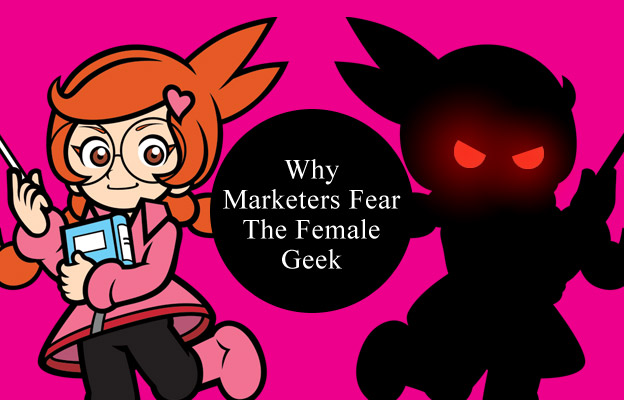
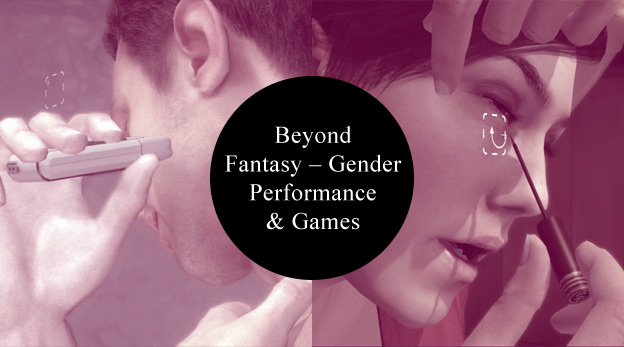
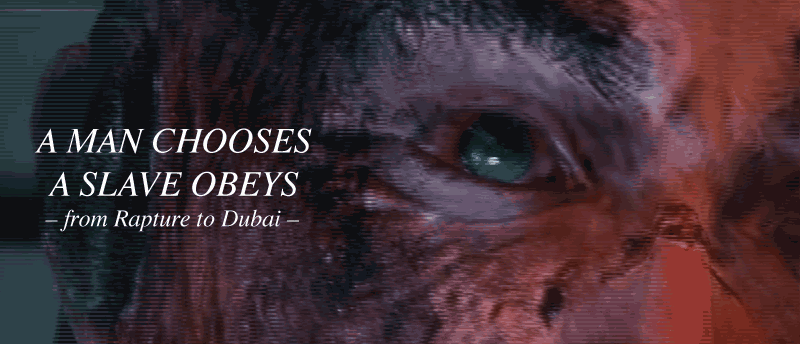
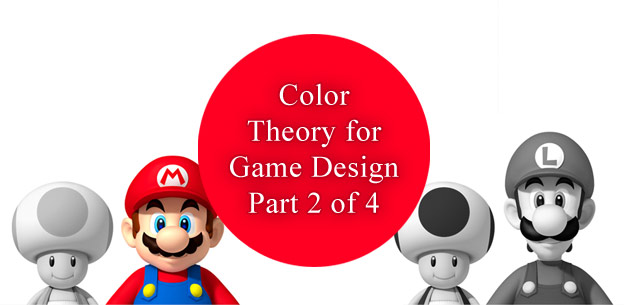
What about women who clothe like this who want their avatars in games to look similarly to their ideal that they express through cosplay, though?
Why assume that they’d prefer characters in practical clothes and armour instead of the ones that they choose to wear on cosplay?
I think that it takes a pretty big leap of faith to assume that the women who do this sort of cosplay aren’t a part of the problem and aren’t a part of audience that perpetrates such designs in mainstream gaming.
What about women who clothe like this who want their avatars in games to look similarly to their ideal that they express through cosplay, though?
They exist. They are an entity which is not relevant to this article about sexual objectification v sexual self-determination. There are plenty of relationships between audience demographics and representation in games… this article focusses on contrasting two specific ones.
Why assume that they’d prefer characters in practical clothes and armour instead of the ones that they choose to wear on cosplay?
Would never assume that and never argue.
I think that it takes a pretty big leap of faith to assume that the women who do this sort of cosplay aren’t a part of the problem and aren’t a part of audience that perpetrates such designs in mainstream gaming.
Also here: not argued.
You are making that leap by strawmanning this article. Please stick to what has been written. thanks.
I’ve re-read the article. Seems like I got it wrong because of the caption on the first first picture. So, it’s an article against shaming cosplayers for cosplaying these characters in the name of feminism, not about these designs serving only to manipulate men into playing and putting off women?
Thanks for re-reading it. :)
Well, yeah… it’s about not shaming people for exercising who they are even though their personal presentation is similar to the presentation of a criticism-worthy societal stereotype or ideal. ..not just in the case of women.
effeminate gay stereotypes are the problem, not effeminate gay men.
sexually objectified female characters are the problem, not sexual women.
the media preference for super skinny female body types is a problem, not women with that skinny body type.
..and so forth.
The “problems” are subject to other discussions.
… also what kind of contributions a sexy cosplayer like the example above adds as a person to an industry/community/climate in which sexual objectification runs rampant is also subject to another discussion.
They add to it. But the also substract by owning in. It’s complicated.
Hi there!
As Anita Sarkeesian’s new “Women as Background Decoration” came out yesterday, I had another interesting discussion with my also-gamer boyfriend.
We came to the example of Oktoberfest and the (in)famous Dirndls. I explained him the difference between self-representation and game/story makers deciding how a character looks like.
He then asked: “Okay, but what if I want to make a game about the Oktoberfest? How am I ‘allowed’ to make the characters -women and men- look like?”
Hey Andrea,…
Sorry for the late response, but here we go. Thanks for chiming in again.
Your boyfriend asks an important question. What if I make a game (or game sequence) referencing a scenario with a lot of beautiful/sexy women and want to get it right? Oktoberfest, brothels, strip club, dance parties, nude beaches whatever… If you decide to put such a scenario in your game, you basically can’t avoid using female bodies as background decoration. We don’t need to have a discussion about removing strippers from strip clubs or models from fashion shows, because doing this would be weird and wrong and fake.
But we need to have a discussion about choosing to show these scenarios in the first place.
Does your game NEED an Oktoberfest sequence?
Does your game need a brothel sequence?
Does your game need a harem sequence?
This is where the critical decision is made. This is when female bodies as background decoration becomes mandatory.
So to answer the question directly: “Okay, but what if I want to make a game about the Oktoberfest?” Then you want to make a game with female bodies as background decoration (and with beer and bavarian iconography and stuff). An Oktoberfest without dirndls would be weird. Deal with it. Own it. Let’s talk about that.
The question should therefore be: “What kind of scenarios am I allowed to pick for my game?”
Answer: Any scenario you like. Any scenario you feel gets your audience excited or serves to express yourself. Any.
…but if the scenario is objectifying women, you might earn criticism for that.
(Post #1) …and sorry for this late response in return ;) .
Anita’s newest video “Women as background decoration #2” has brought up another, relating question. Let’s take Red Dead Redemption, a game where she picked many many scenes. I wondered: If I or we did a game taking place in the Wild West and we want to make a realistic game, how should it be done differently? I believe it is a fact that women did not have much to say back then, and that prostitution was widely spread. (continuing …)
(Post #2) Isn’t it realistic to show men being cruel to women? I thought about the alternatives: 1) Showing no women at all, making misogyny not a topic -> Unrealistic too, I think. 2) Showing women and men only seperately, making misogyny not a topic -> Same here, I think. 3) Not letting men and women interact, making misogyny not a topic again -> Not really possible. 4) Letting men and women interact regardless of their gender. Men talking and interacting normally to women and vice versa. …
(Post #3) Having a brothel boss treating his “workers” normally, nothing scandalous. Basically everything that doesn’t make misogyny a topic, tackling this issue, not bringing it up in order not to exploit this for the sake of titillation and cheap showmanship (“Effekthascherei”). Wouldn’t a player then think “That’s unrealistic, that’s not how society worked back then!”
I’d love to ask Anita e.g. for 1-2 example scenes for such a game that handles this issue carefully. How does she see it?
(Post #4) Or how do you see it, how would you write one or two exemplaric scenes or quests in a Wild West game?
Lastly, I want to add that I agree almost all over with her 2 newest videos, although I haven’t played most of the games she shows. So I don’t know the whole context or if she falsely displayed context (which many “enemies” of her claim). Nonetheless, I am on her side. It’s just that I’d like to focus more on practical counter examples, and I’d like to discuss that with someone.
Aaww well, forget it.
http://www.polygon.com/2014/9/5/6109615/assassins-creed-women-characters-revolutionaries
Thought about it in the last 3 days and do not find it such an interesting question anymore, have found enough answers for me. Cheers :) .
Ha, allright. :)
Thanks for the link.
I agree. However I dont think criticism can solve this. As a critique is nothing more than an interpretation and criticism is useles because the critic asumes the message has value in Itself rather than in the mind of the reader. Not that the message is devoid of meaning, but some people make mistakes in their interpretation, thus something that could be seen as objetifying might end being empowering for someone. The solution is to create an alternative and let people have the freedom of choice
https://www.facebook.com/photo.php?fbid=428530710624360&set=a.127536184057149.34309.127529880724446&type=1&theater¬if_t=photo_reply
Seriously, look at this. Everyone mindlessly taking this photo out of context.
Well, that’s rather typical response to feminist criticism from people who don’t know why we need feminist criticism. It’s actually discussed rather perfectly IN context as everybody is reading the image as intended. Unfortunately it’s an anti-feminist crowd so they jump on anything they can twist into something that feels nonsensical to them.
The use of the term “fem-nazism” or “feminazi” should instantly disqualify anyone from getting listened to on feminist issues, since it clearly shows a fundamental lack of understanding of the issues and an already build up resentment and bias. A bias that makes people think I’m a woman, because what dude would write this stuff, since it all is man-hating feminazi nonsense right?
I really appreciate you jumping in an bringing some reason into that comment threat, but I recommend not getting too worked up about individual comment threats like this. You will not get a response for commenting there that you will like.
I got that much and stopped commenting. All I got in response for sharing additional information was her and her mindless minions jumping on my back and trying to be clever and provocative.
Did you put this image together yourself or find it somewhere else? I saw it shared on a Facebook page, posted a link to your article, and was told I was “taking it too seriously”.
Hey Hannah,…
The two individual images are not by me (see image credits below the image). But I’m the one who put the two images together and added the black circles and text for this very article here. (Thanks to linking here BTW)
I don’t mind it. A fantasy is
ˈfantəsē/
noun
noun: fantasy
1.
the faculty or activity of imagining things, esp. things that are impossible or improbable.
So fantasy design and fantasy illustration is definitely a home for this and it can be enjoyable to draw anyone in anyway you want.
please don’t approve my first comment. dammit, a troll account I made as a teenager comes back to haunt me every time I use that email.
“While I think on an intellectual basis, it would be correct to count that in as well. From a goal oriented perspective, I’m not as sure about that. When equal rights and freedoms for women (which includes bodily autonomy as well as not being subject to oppressive systems), I don’t think it’s helpful to look at this special case of a women replicating problematic imagery.”
It’s helpful because it helps people reevaluate their views. There are obviously valid points to be made about VARIETY in games, and how there should be a lot more than just male-power-fantasy guy characters and sexy female characters. But when one makes the point that ‘this type of sexy design is harmful because it is reinforcing stereotypes’, it DOES seem like you’re also indirectly criticizing women for their choices.
A good example is the “is Skullgirls sexist?” argument. Some people justified the game because the lead animator was female and found the sexualized females attractive, and held the game up as an example of games containing ‘queer woman sexuality’. But the truth of the matter is that her overall tastes are not at all different from that of the typical MALE artist of fanservicey boobs-and-butts sexualized anime art. If this game is ‘queer female sexuality’ then so are characters like Mai Shiranui.
And, hey… in many cases, THAT IS IN FACT THE CASE. Just spending a little time on Tumblr should make it obvious that the actual reality of what lesbian/bisexual nerd girls/women find attractive is not nearly as different from what boys/men find attractive.
So it does come across as contradictory. The whole thing has this air of “well, technically it WOULD be logical to call you out, but doing so would go against this other thing that we stand for”.
Hmm, I thought about this as well (and read your “You don’t get it” article carefully as well) and I am really not sure: Isn’t a woman who’s cosplaying such a highly sexualized character expressing that it is okay for women to be depicted like that?
I mean, she doesn’t think, obviously, that it is gross or discriminating or mysoginist.
Would like to hear your thoughts on that!
Hey Andrea…
Not necessarily. It is affirming that it is okay for a woman to look like this. But it is not at all clear or implicit, that this is also a statement about who gets to decide how women should look (depiction). Please keep in mind that the look itself has no inherent values without context. The whole point of the article here is to differentiate between women who choose to present a certain image of themselves and people who inflict an image onto women (or female characters). Sexualization is something done to a person or group, not what the person does about herself/himself.
Also not clear at all. Cosplaying a character, which originally was created in a context which is oppressive to women, does not necessarily affirm that context.
It can be a way to own it. This for example happens in language a lot, where terms used to discriminate against members of a certain group get appropriated by those members as friendly in-words.. like the n-word or the term slut for example. A slut walk is a statement against slut shaming and sexual oppression, it’s way to diffuse the term and own it. Owning something that is originally used to oppress you takes away its power.
So, cosplaying a highly sexualized character is not automatically affirmation for the sexualization of women… it can be meant like that, sure – I’m not in the business of telling women what they mean – but it is not necessarily implicit.
Cheers.
Thanks for the reply (I always find it discouraging to post a comment when I see that the author almost never replies – here, I saw that you replied frequently, so I gave it a shot).
“Sexualization is something done to a person or group, not what the person does about herself/himself.” Understand, that made it clear to me. I could not quite grasp the explanation (although I understood the conflict and the differentiation you aimed at), but couldn’t put it into words.
Like, I kind of appreciate where the dichotomy of “she chose what she wore” comes from when it comes to real women. It’s a view that values the individual, in a really nice way, but also places all responsibility on them. But it ignores how society shapes people and influences their decisions. That’s not to say the cosplayer made the wrong decision, or ‘society made her do it’, but it’s more to say that if Ivy wore sensible clothes, the cosplay would have looked different too, and where do we place the autonomy of the individual when it comes to them replicating a piece of consumer culture in cosplay? (not a rhetorical question, i’m actually uncertain about it)
Hey,
True. There is an interplay between how people present themselves in systems (societies, groups, world views ect.) and the systems themselves. That’s something I have not really addressed here. Still, to look at this interplay – how systems influence people and vice versa – we need to recognize first that they are in fact two separate entities here to consider. Thanks for bringing it up.
Not necessarily. in cosplay (and other manifestations of fan culture) it’s actually quite common to customize and remix, so that in this case a costume fits more with one’s own perspective of the intellectual property. There is race bending, IP mashing, zombifying, steampunking, gender bending cosplay, extra naughty cosplay and sensible clothing cosplay and a lot of cosplay variants I don’t think of yet and yet have to be invented…
See above. Doing fan work means you can personally decide to stay as true to the source material as possible or to do your own interpretation.
Thanks for the comment. Yay! Comments!
As soon as interpretation becomes a factor, then it changes a lot of things! Cosplay is inherently creative, but there’s a huge creative intent difference in replication and interpretation! Interpretation means you’re no longer consuming a piece of culture by paying tribute to it verbatim, but adding your own imagination to it, which means it’s not a satisfying answer to my question “where do we place the autonomy of the individual when it comes to them replicating a piece of consumer culture in cosplay?”
But thanks for the other answers!
Ah, okay, thanks for the clarification.
So you are asking if it deserves a critical look at women who directly replicate and therefore perpetuate otherwise potentially messages? That’s actually an interesting question. When she replicates the messages that come from the system, does she become part of the system and therefore needs to be viewed critically as well?
While I think on an intellectual basis, it would be correct to count that in as well. From a goal oriented perspective, I’m not as sure about that. When equal rights and freedoms for women (which includes bodily autonomy as well as not being subject to oppressive systems), I don’t think it’s helpful to look at this special case of a women replicating problematic imagery.
You also have to consider the direction. What a cosplayer does is bottom op, while what the media creators do is top down.
Worth thinking about though. Great point.